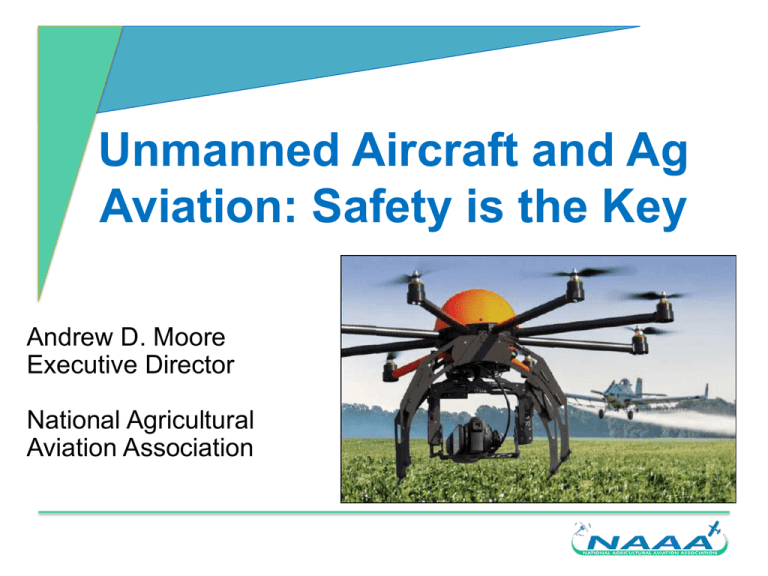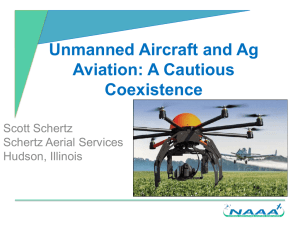Low-Level Manned Aircraft Hazards
advertisement

Unmanned Aircraft and Ag Aviation: Safety is the Key Andrew D. Moore Executive Director National Agricultural Aviation Association Contents • The Importance of Ag Aviation • UAS/UAVs in the News • UAS Prospects and Potential Uses • UAS Rules • Low-level Manned Aircraft Hazards • NAAA UAS Safety Concerns • UAS Liability Issues • Conclusion The Importance of Ag Aviation • • • • • 1,350 aerial application businesses in the US; plus 1,430 additional nonowner ag pilots. 18.75 percent of all crop protection products applied on commercial farms are done so aerially. 71 million acres of cropland each year—doesn’t include pasture, rangeland or urban uses. Used for crop protection; to protect forestry; protect waterways and ranchland from invasive species; and control mosquitoes and other health-threatening pests Allows rapid treatment of large, remote areas; hard to reach areas and orchards and late stage crops without causing damage UAVs in the News Drone operator says he accidentally crashed device on White House grounds - The Washington Post 1/26/15 Man vs Drone: Some Pilots Fight Back Against Robots - Wall Street Journal 1/15/15 FAA rules might allow thousands of business drones - The Washington Post 2/15/15 Market and Use Studies UAV Prospects • AUVSI Study – $13.6 billion economic impact within the first three years of integration, $82.1 billion between 2015 and 2025 • Lux Research Study – Ag drones could generate $350 million in revenues by 2025 from an estimated 330,000 U.S. units. • Clemson University’s Edisto Research & Education Center – A UAV can analyze a 10-acre field in less than 5 minutes, work that take a person days or weeks to complete Proposed Ag UAS Uses Being Conducted Now by Manned Aircraft & Satellites • Crop Sensing – Crop condition assessment imaging systems can be used for pest detection. – Airborne imaging systems offer advantages over satellite due to relatively low cost, high spatial resolution, easy deployment and real time availability of imagery for visual use. – At 500 ft. a pixel covers 1.4 in. and 500 ft. x 330 ft. of ground; at 10,000 ft. a pixel covers 28 in. and 1.9 mi. x 1.2 mi. of ground. Nikon camera mounted on the step of an ag aircraft. A GPS receiver and video monitor integrated with the camera are mounted in the cockpit. Proposed Ag UAS Uses Being Conducted Now by Manned Aircraft & Satellites • Aerial Imaging – Software can be used to perform basic image processing and create prescription maps for precision application. – 2012 NAAA Survey found that 21% of ag aviators use flow control devices for variable rate application (precision agriculture). – UAS are another tool that can collect these images and data for precision ag A color image acquired at 4,000 ft. AGL over a cotton field infected with cotton root rot using an ag aircraft. On the color image, healthy cotton plants have a dark green color, whereas infected plants have a grayish tone similar to bare soil. UAVs Used for Aerial Application Purposes • UAVs in Japan – 90 percent of crop protection in Japan is performed by UAVs (4 gallon RMAX helicopter) – Average farm size in Japan is 1.5 hectares (3.7 acres), compared to 441 acres in the US. – RMAX hopper 4 gallons vs. 300+ average tank size for a modern ag aircraft – RMAX spraying speed 15 mph vs. 160 mph for a manned ag aircraft UAV Efficacy and Cost Concerns • Application efficacy issues with today’s UAVs compared to larger manned ag aircraft due to downward thrust-toweight ratio—the amount of air pushed down to the crop canopy—from a rotor or fixed wing—is proportional to the weight of the aircraft that the air is holding up. • Larger ag aircraft aide in thorough and efficient application of crop protection product • A four gallon, 15 mph Yamaha R-MAX costs $86,000. Large UAVs cost in multi-millions of dollars and are not available for application. Manned ag aircraft range from $100,000- $1.5 million (800 gallon 160 mpg) and by far have the cost, speed and efficacy advantage. FAA Rules for UAVs • UAVs first mentioned in 2004 FAA Reauthorization (P.L. 108-176) • Extensive provisions provided in the FAA 2012 Reauthorization – Mandate for full integration by Sept. 30, 2015 – Propagation of special rules for UAVs under 55lbs (released for comment February 2015). Current FAA UAS Use Policy • Methods of legal UAV commercial operation: – Petition for a use under Section 333 – Operation under the Small UAS Rule (expected promulgation 2017) Sec. 333 Petitions • Established under the 2012 reauthorization, permits limited use of UAVs for commercial purposes • Administrator must consider at a minimum the UAVs size, weight, speed, operational capability, proximity to airports and populated areas, operation within visual line of sight, and national security implications Sec. 333 Petitions (con’t.) • Currently 325+ petitions pending (Many granted) • Sectors vary from agriculture, to real estate to filming to search-and-rescue • NAAA has commented on a number (60 thus far) of these petitions • Remain only legal method of commercial use until final small UAS rule is adopted (estimated 2017) • Exemptions granted require private pilot’s license, 48 hour NOTAMs, operation within line of sight, preflight inspection, and registering the UAV with an N-number. Small UAS Rule • On Feb. 15, 2015 the FAA released it’s long awaited small UAS rule • Ignored many of NAAA’s UAS recommendations and even the agency’s own safety measures used in Sec. 333 exemptions Small UAS Rule Summary • Applicable to UAS 55 pounds or less being operated for compensation or hire – Not applicable to “model aircraft,” (operated for hobby or recreational purposes) – Prohibits some operations (external load, air carrier, international, and foreign-owned aircraft). Prohibits night operations. • Requires operation within “visual line of sight” of the operator. – Operator may only operate the UAS within range of “natural vision” – UAS must give way to manned aircraft Small UAS Rule Summary • • Operator must self-certify that they have no condition that would medically prevent them from seeing and avoiding aircraft (no medical exam required) Creates training requirements for operators – – • Requires UAS to be registered with the FAA – • UAS must receive and display on the aircraft a aircraft registration number “N number” Operator must assure prior to flight that the aircraft is airworthy – • Written operator exam to be taken at a FAA certified test center A recurrent written test must be retaken every two years Unlike manned aircraft, there is no requirement for a FAA certification for airworthiness Requires coordination with ATC when operating in controlled airspace and airport operators when operating near airports Low-Level Manned Aircraft Hazards – Birds: birds try to avoid collisions, they are very motivated and usually they take sufficient evasive action to avoid their peril, yet… – Birds are the second leading cause of aviation fatalities – 142,000 wildlife strikes with civil aircraft between 1990 and 2013, with 25 fatalities Above: Luckily, operator Steve Fletcher only sustained minor injuries when a buzzard blew out the cockpit window of his Air Tractor 802 while he was flying. Low-Level Manned Aircraft Safety Hazards • • Unmarked Towers – Since 2005 7 percent of aerial application accidents were the result of collisions with towers – Since 2005 15.5 percent were the result of collisions with wires UAS? June 2014 Washington Post Article: – 400 accidents/incidents involving military UAVs – Dozens of near-misses between commercial aircraft and illegally operating UAVs – Two near misses between ag aircraft and UAVs in 2014 Fatal Air Tractor collision with a meteorological evaluation tower (MET). August 2013. Fatal Accidents (Ag Aviation)--2014 » NAAA’s UAV Safety Concerns • UAV inability to “Sense and Avoid,” Manned aircraft’s inability to see/sense UAV – GAO: No adequate technology currently exists that would allow UAVs to sense and avoid other traffic • Security Concerns – UAV “spoofing” or hacking • “Lost Link” concerns – Some aircraft have no lost link procedure and continue flying until they hit a obstacle or run out of fuel NAAA Safety Recommendations • NAAA is urging the FAA and Congress that UAVs be required to have: – ADS-B Out transponders – Strobe lights • To identify operator’s vehicle (line of sight) and UAV – Marking similar to that required for other low-level obstacles (aviation orange and white paint) – Monitoring of a locally defined radio frequency – Distraction-free operation of the UAV NAAA Safety Recommendations (continued) • Pilot training: – Commercial pilots license and UAS operations type-rating – Reoccurring training – Class 2 Medical – Commercial Pesticide License if treating crops, if used for application • Operation within visual range of the operator (line-of-sight) • Aircraft airworthiness – Similar to manned aircraft, certified airworthy NAAA Safety Recommendations (continued) • Medically qualified observer (line-of-sight) • Registered with an indestructible “N-Number” • Issuances of NOTAMs when UAVs are operating • Immediate grounding of the UAV if a low-level manned aircraft is operating within two miles Small UAS Rule vs. NAAA’s recommendations • • • Accepted NAAA Recommendations – Mandatory UAS registration – Manned aircraft have the right-of-way over unmanned aircraft Ignored Recommendations – No ADS-B Out requirement – Strobe lighting – No medical requirements – No airframe certification – No pilots license or UAV experience necessary (written test only) – No aviation orange and white painting NAAA is filing comments Responsibility and Liability • UAV Insurance currently offered by certain insurance providers • § 107.37 of FAA Proposed Rule for UAV’s states: “(2) Yielding the right-of-way means that the small unmanned aircraft must give way to the aircraft or vehicle and…No person may operate a small unmanned aircraft so close to another aircraft as to create a collision hazard.” • Farmer insurance policies typically only cover between $100,000 and $300,000 in damages, and only in limited circumstances if at all when it comes to aviation • $6.7 million wind energy settlement demonstrates liability Conclusion • NAAA supports the safe integration of UAVs into the NAS, and urges the FAA to carefully consider all of the manned aviation industry’s safety concerns when integrating UAVs into the national airspace and urges the agency to follow a comprehensive, well thought out safety-oriented approach using the association’s recommendations. • UAVs will likely not be used for spraying anytime soon, but have crop sensing, aerial imaging and other non-application capabilities. Manned aircraft, such as ag aircraft are able to conduct crop sensing and aerial imaging services too. • Considerable liability risk for UAV operators and providers. Questions? National Agricultural Aviation Association www.agaviation.org admoore@agaviation.org 202-546-5722





